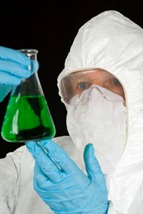A Shell Game in the Gulf
 Because FDA scientists have declared the 1.8 million gallons of Corexit, the dispersant that BP sprayed into the Gulf, less dangerous to human health than the oil it dispersed, the FDA has decided not to monitor fish and shellfish for the presence of Corexit at all. Instead, the agency is testing samples of seafood only for the presence of oil, and it’s doing that by passing them under the noses of “sensory experts,” who check the samples for oil odor. Asking us to eat seafood that has just been exposed to vast volumes of an untested chemical because it has passed a smell test for something else is not reassuring.
Because FDA scientists have declared the 1.8 million gallons of Corexit, the dispersant that BP sprayed into the Gulf, less dangerous to human health than the oil it dispersed, the FDA has decided not to monitor fish and shellfish for the presence of Corexit at all. Instead, the agency is testing samples of seafood only for the presence of oil, and it’s doing that by passing them under the noses of “sensory experts,” who check the samples for oil odor. Asking us to eat seafood that has just been exposed to vast volumes of an untested chemical because it has passed a smell test for something else is not reassuring.
The terms the FDA has used to reassure us should also leave us uneasy. FDA scientists have been quoted as saying that they do not believe (italics added) that the chemicals accumulate significantly in the tissue of fish and shellfish; that they do not appear to threaten the safety of seafood in affected waters. It should give us pause when scientists tell us what they “believe,” instead of what they know; when they tell us what “appears” to be true, rather than what their tests show to be the case.
 One questions how the FDA arrived at the conclusion that “chemicals used to break up the slicks are not as dangerous to human health as the oil itself.” When a scientist makes this sort of statement, he/she usually shelters statements like this with “tests have demonstrated” or “studies have shown.” But since Nalco, the manufacturer of Corexit, didn’t disclose the ingredients until late 0May, how could the chemicals have been tested? The disclosure noted that the mix did include a proprietary form of sulfonic acid salt, which is "moderately" toxic to freshwater fish and invertebrates but which, the manufacturer says, degrades quickly.
One questions how the FDA arrived at the conclusion that “chemicals used to break up the slicks are not as dangerous to human health as the oil itself.” When a scientist makes this sort of statement, he/she usually shelters statements like this with “tests have demonstrated” or “studies have shown.” But since Nalco, the manufacturer of Corexit, didn’t disclose the ingredients until late 0May, how could the chemicals have been tested? The disclosure noted that the mix did include a proprietary form of sulfonic acid salt, which is "moderately" toxic to freshwater fish and invertebrates but which, the manufacturer says, degrades quickly.
We can believe it degrades as it’s exposed to the sun on the surface. But when does it degrade after a fish ingests it? What if we eat the fish before the Corexit it has swallowed, degrades? And even if the fish ingests so little Corexit that its effect on ingesting humans is negligible, what happens when a bigger fish eats lots of the smaller fish that have absorbed the dispersant and we eat the bigger fish?
 Then, what should we make of the Safety Data Sheet that accompanies each container of Corexit 9527, the main version of the chemical BP used in the Gulf? Anyone who handles it is supposed to wear a complete Hazmat getup, including goggles and a respirator. It is true that this gear is for the chemical at full strength, which is not what’s in the Gulf. But for something that is rated as a hazardous substance by Nalco, and can destroy red blood cells and damage the liver and kidneys if it gets on the skin or is inhaled, it seems cavalier for the FDA to have beliefs and assumptions, without hard data that the sea creatures that will swim in water laced with it are still safe to eat.
Then, what should we make of the Safety Data Sheet that accompanies each container of Corexit 9527, the main version of the chemical BP used in the Gulf? Anyone who handles it is supposed to wear a complete Hazmat getup, including goggles and a respirator. It is true that this gear is for the chemical at full strength, which is not what’s in the Gulf. But for something that is rated as a hazardous substance by Nalco, and can destroy red blood cells and damage the liver and kidneys if it gets on the skin or is inhaled, it seems cavalier for the FDA to have beliefs and assumptions, without hard data that the sea creatures that will swim in water laced with it are still safe to eat.
And what about the vast plumes of oil that were discovered spreading south from the Deepwater spill? They too were mixed with Corexit. As the plumes sank under the surface of the Gulf, they also sank from the public consciousness. Without any information to the contrary, we must assume they are there, biodegrading more slowly in the colder and darker waters, but still, waters in which fish swim – and eat.
Having dispatched Corexit as a problem, the FDA continues to smell for oil. One can’t help but be reminded of the old joke about the drunk who has lost his keys in the bushes but is looking for them under a street light because “That’s where the light is.” The FDA is testing for the toxic oil it knows rather than for the dispersant, about which it appears to have nothing but Nalco’s assurances. So we are left in the dark about what the real effects of the dispersant will be – on our health and the health of everything that lives in the Gulf.


